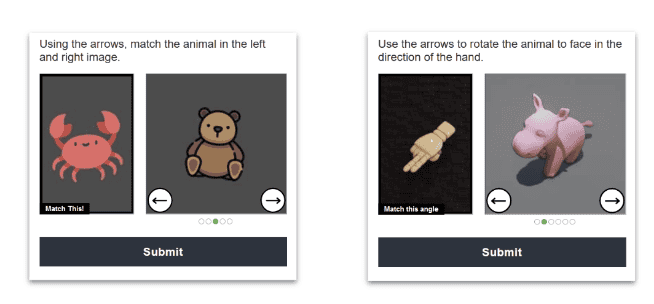In the digital world, online security is of utmost importance, especially when it comes to sensitive information such as financial transactions and personal data. CAPTCHA is a widely used security mechanism that helps prevent automated bots from accessing online resources and exploits. The goal is to create a task that is easy for humans to complete but difficult for bots to solve. CAPTCHA is a simple yet powerful tool that can help protect an application, business, or organization from spam, brute-force attacks, and other security threats.
By implementing the best CAPTCHA practices, companies can increase the security of their online assets and protect their users' personal information. Additionally, CAPTCHA practices can ensure that their websites and applications are secure and user-friendly, thereby building trust and credibility with their customers.
The Ideal CAPTCHA: Arkose MatchKey Has Defensibility, Usability & Accessibility
What is CAPTCHA and why is it important for businesses?
CAPTCHA stands for "Completely Automated Public Turing test to tell Computers and Humans Apart." It's a security measure that helps to differentiate between humans and bots by presenting a challenge that bots cannot solve. CAPTCHA challenges commonly ask users to type in distorted text or characters. CAPTCHAs prevent automated attacks such as spamming, credential stuffing, and brute force attacks. CAPTCHA is important for businesses because it helps prevent automated attacks, which can cause damage to user data and reputation. It ensures that online interactions are conducted by real human users, increasing security and reducing fraud risk. Additionally, it can help businesses comply with data privacy regulations.
The different types of CAPTCHA and their effectiveness
CAPTCHA can come in various forms, such as image-based, audio-based, math-based, text-based, and even game-based challenges.
- Image-based CAPTCHA: Image-based CAPTCHA requires users to select certain images that fit a specific description, such as choosing all the photos that contain a car or a street sign. This CAPTCHA type effectively prevents automated bots from accessing a website.
- Audio-based CAPTCHA: Audio-based CAPTCHA involves playing a series of distorted or garbled audio clips and requiring users to enter the correct words or phrases they hear. This type of CAPTCHA is helpful for visually impaired users.
- Math-based CAPTCHA: Math-based CAPTCHA requires users to solve simple mathematical equations, such as adding two numbers together or subtracting one number from another. This type of CAPTCHA is simple but effective at preventing automated bots from accessing a website.
- Text-based CAPTCHA: Text-based CAPTCHA displays distorted letters or numbers that users must type incorrectly. This type of CAPTCHA is widely used and can be difficult for automated bots to solve.
- Game-based CAPTCHA: Game-based CAPTCHA requires users to play a simple game, such as dragging and dropping objects into the correct places, to prove they are human. This type of CAPTCHA is fun and engaging for users but may not be as effective as other types of CAPTCHA at preventing automated bots.
The effectiveness of CAPTCHA practices varies depending on the type. While some varieties, like image-based CAPTCHA and audio-based CAPTCHA, can be effective in preventing automated attacks, others, like text-based CAPTCHA and math-based CAPTCHA, are less effective due to advancements in AI technology. Game-based CAPTCHA is a relatively new type that shows promise in effectiveness.
Implementing CAPTCHA on your website or application
Using a variety of CAPTCHA practices is generally recommended to improve the overall effectiveness of CAPTCHA in preventing automated attacks. The most effective approach is to use a combination of challenges, such as text-based and image-based CAPTCHA, as this can make it harder for attackers to develop automated scripts to bypass the obstacles.
CAPTCHAs that are too difficult or frustrating for users can impact the user experience and deter users from engaging with your website or application. If the CAPTCHA is too challenging or confusing, users may become frustrated and abandon the process, leading to a higher bounce rate and potentially lost business opportunities. Therefore, it's important to balance security and usability when implementing CAPTCHA practices to ensure a positive user experience while effectively preventing automated attacks.
Making sure that the CAPTCHA is accessible to users with disabilities is essential for ensuring that everyone can access your website or application. One way to do this is by including an audio-based CAPTCHA option for users with difficulty reading visual challenges. Additionally, providing alternative text for the CAPTCHA image can help users with visual impairments who use screen readers understand the challenge. It's also essential to ensure that the CAPTCHA is compatible with assistive technologies such as screen readers and magnifiers. By making sure that your CAPTCHA is accessible to users with disabilities, you can improve your website or application's overall usability and inclusivity.
Using a third-party service for managing your CAPTCHA can offer several benefits. It can save time and resources by handling the implementation and maintenance of the CAPTCHA and may also provide additional features such as advanced security measures and analytics. Additionally, third-party services may have a larger pool of resources and expertise to continuously improve the effectiveness of the CAPTCHA continuously.
To monitor the effectiveness of your CAPTCHA, you should regularly review your website or application's analytics and user feedback to determine any issues with the CAPTCHA. If users repeatedly fail or complain about the CAPTCHA, it may be too difficult or frustrating for them. Someone can make more adjustments to make it more user-friendly while still being effective against bad bots. It is also important to stay up-to-date with new CAPTCHA techniques and technologies to ensure your security measures are always effective.
Addressing any issues or complaints related to the CAPTCHA practices is essential because it can negatively impact the user experience and discourage users from using your website or application. You must address these issues to avoid losing business opportunities and damaging your reputation.
By following these CAPTCHA best practices, businesses and organizations can effectively balance security and usability while protecting themselves and their users from malicious activities.
Alternatives to traditional CAPTCHAs, such as behavioral analysis and biometrics
Instead of relying solely on traditional CAPTCHAs, which can be frustrating for users and potentially less effective against sophisticated attacks, businesses can consider implementing alternative authentication methods such as behavioral analysis and biometrics.
Behavioral biometrics and analysis are two alternative security measures businesses can use in place of CAPTCHA to prevent automated bots from accessing online resources. Behavioral analysis involves monitoring a user's behavior to determine whether they are human or a bot. For example, behavioral analysis can include analyzing mouse movements, keyboard patterns, and other user interactions to detect unusual behavior typical of bots. Behavioral analysis can be practical because bots typically interact with websites differently than human users, so their behavior can be seen and prevented.
Biometrics involves using a user's unique physical or behavioral characteristics to verify their identity. Biometrics includes facial recognition, fingerprint scanning, voice recognition, or gait analysis. Biometrics can be effective because each individual has unique characteristics that are difficult to replicate, and therefore it is difficult for bots to mimic these characteristics.
Both behavioral analysis and biometrics can be effective alternatives to CAPTCHA practices because they are more user-friendly and less intrusive. Unlike CAPTCHA, which often requires users to solve puzzles or enter codes, behavioral analysis, and biometrics can verify a user's identity seamlessly in the background without requiring additional action. This can improve the user experience and make it easier for users to access online resources securely.
Arkose Labs MatchKey CAPTCHA alternative
Arkose Labs' MatchKey is a next-generation CAPTCHA alternative that utilizes a unique challenge-response mechanism to protect against fraudulent activity on websites and applications. Unlike traditional CAPTCHAs, which rely solely on distorted text or images to distinguish humans from bots, MatchKey uses a dynamic challenge-response system that adapts to each user's behavior.
MatchKey challenges users to complete a simple task, such as dragging an object to a target location, within a short time frame. The challenge is easy for humans to complete but difficult for bots to automate. Additionally, MatchKey uses behavioral analysis to assess the user's interaction with the task, such as how they move their mouse or tap their screen, to verify that they are human.
One of the key benefits of MatchKey is that it is highly resistant to advanced bot attacks, such as machine learning and artificial intelligence-based attacks, which can easily defeat traditional CAPTCHAs. MatchKey also provides a better user experience, as it is less frustrating and time-consuming than conventional CAPTCHAs.
If you aren't yet a customer, please come join us. Request a demo to see how we can help you stop automated attacks that result in account takeovers, credential stuffing fraud, new account fraud, bonus abuse fraud, and much more.


